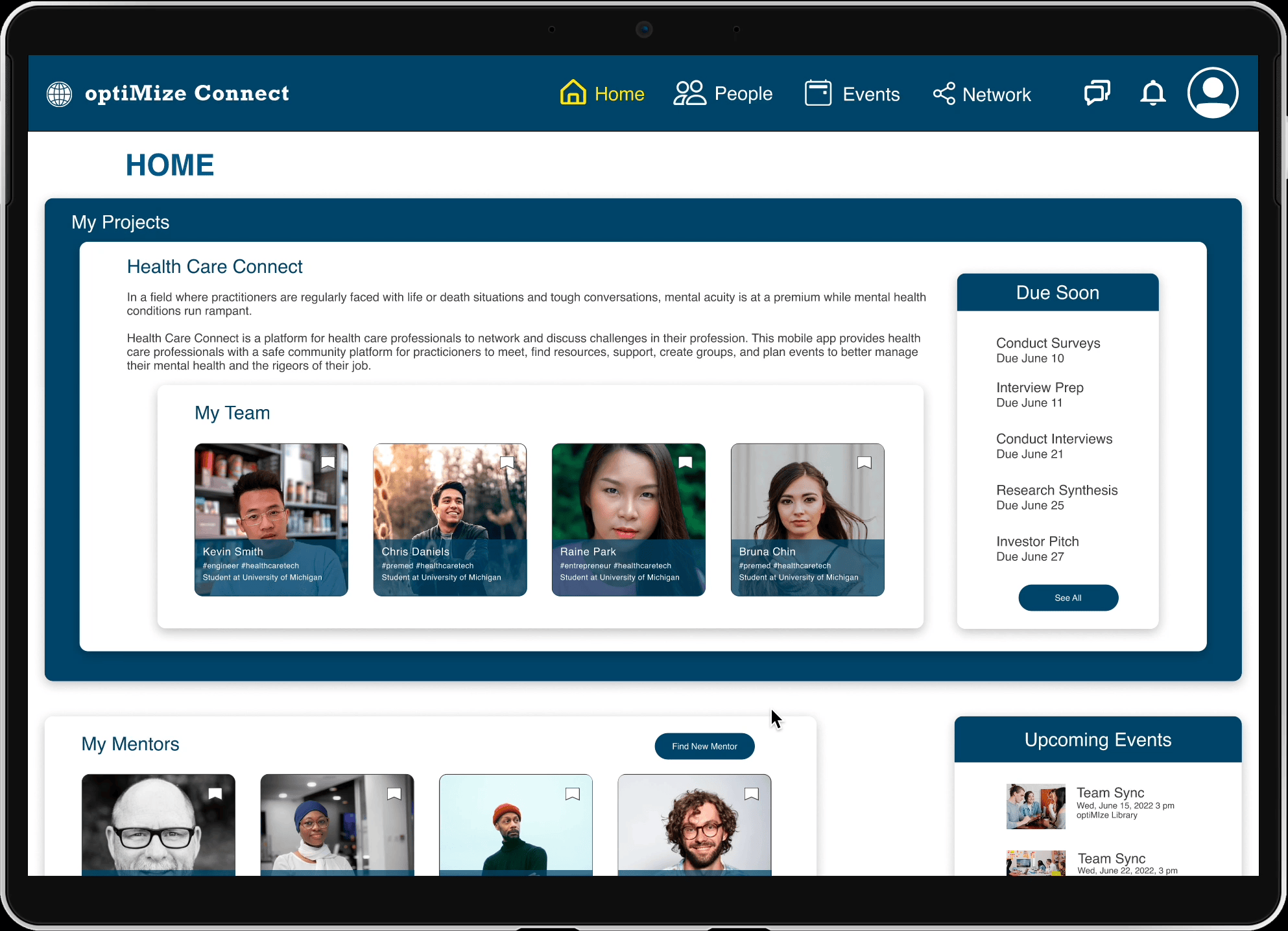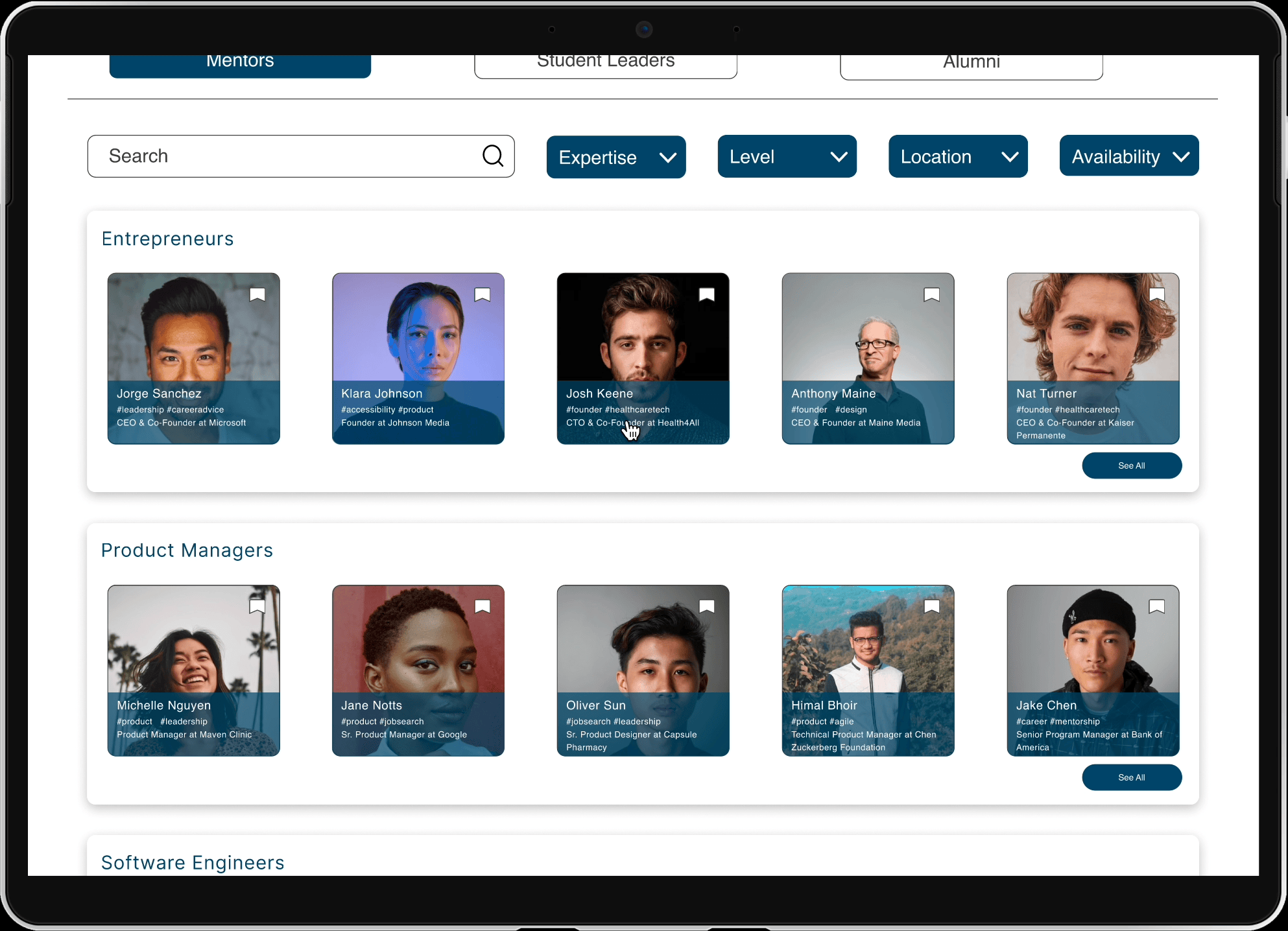optiMIze Connect
Mentorship platform redesign: Helping students find and connect with mentors that match their needs in a more efficient way
OVERVIEW
optiMIze Connect needs a service that connects mentors and mentees. I created a streamlined and user friendly solution to make the process of finding mentorship easier.
ROLE
Product Designer who conducted extensive research to create a user-centered website design.
DURATION
2 week sprint
METHODS AND TOOLS
Screener Survey
Competitive and Comparative Analysis
User Interviews
Affinity Map
Persona
User Flow
Design Studio
Wireframe and Prototyping
Design System
Usability Testing
Tools: Figma, Pen + Paper
CHALLENGE
How can I curate an impactful mentorship relationship?
Student leaders needs clear communication, empathy, and a structured mentoring relationship so that they can strengthen their entrepreneurial and leadership skills and have a successful product launch.
SOLUTION OVERVIEW
OptiMize Connect is a platform that connects eager mentees to experienced mentors. It encourages structured and transparent communication in order to create strong and productive relationships.
Navigating towards “happy path” of exploring mentors
Home page is designed to lead students to find and explore a mentor. Mentees can quickly narrow down mentorship candidates using important attributes such as expertise and availability.
Finding a mentor
Mentor profile pages are carefully designed to give mentees the important information they need to feel comfortable setting up a meeting.
CONTEXT & SURVEY
Why do students seek mentorship?
optiMize is an organization at the University of Michigan that offers mentorship, funding, and special programming for student leaders to start their own social innovation projects and companies. Through optiMIze, student entrepreneurs receive guided support from one another and from industry experts so that their projects can become a reality.
Student leaders need a new platform where they can connect to one another and to industry mentors who can guide them through their entrepreneurial vision.
To initiate the research process, I created a screener survey to gain context on mentorship through 55 responses. I gained quantitative and qualitative data, especially regarding the communication between mentor and mentee
COMPETITIVE & COMPARATIVE ANALYSIS
Learning from competitors and comparators
Our direct competitors, ADP List and Mentor Cruise, allow users to connect with mentors from a range of industries and experience levels, a valuable feature given that our users have such diverse interests. Meanwhile, our indirect competitors are social networking platforms that have outstanding messaging features and browsing experiences.
PERSONA
Defining the mentee and their goals
Through user interviews and affinity mapping, I developed a persona. The student leader represents our target audience.
USER INTERVIEWS
Conversations and findings with mentees
By conducting and analyzing 12 user interviews, mentees showed a lot of collective needs and goals. I accumulated insights through an affinity map, and defined clear takeaways.
USER FLOW
Mapping out how users will navigate the website
Next, I mapped out a high-level user flow to attain 1 main goal: The Student Leader wants to meet a mentor through clear communication and structure. Imagining different flows helped me break down the key steps that were necessary for the new platform.
User flow “happy path” that is clear and checks all the boxes a mentee needs to find a match.
DESIGN PROCESS: BRAINSTORMING AND SKETCHING
Brainstorming with the target audience in mind
Sketching was the beginning of the design process and this allowed me to explore my early ideas with low-stakes.
FINAL PROTOTYPE
Final Flow for mentees to find their best match
Home page is designed to lead students to find and explore a mentor. Mentees can quickly narrow down mentorship candidates using important attributes such as expertise and availability.
Mentor profile pages are carefully designed to give mentees the important information they need to feel comfortable setting up a meeting.
Messaging and Mentorship Request form emphasizes our efforts for clear communication.
The best elements from all the sketches were implemented in mid-fidelity wireframes in Figma.
Conclusion, What I learned, Next Steps


















